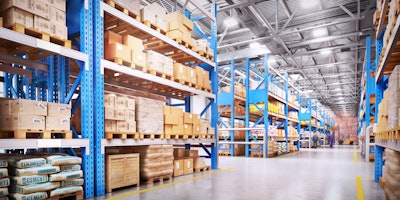
Supply chains have faced a rough two years, to put it mildly. Rising demand, overlaid with manufacturing and transportation delays, has made arduous the process of delivering goods to customers. For many in the supply chain space, particularly warehouses, technology has proven an invaluable solution.
Three meaningful warehousing sector trends are driving investments in new technologies: The ongoing labor crunch (the most influential trend); a renewed mandate for more operational flexibility; and global initiatives for digital transformation across businesses.
Here’s how each trend is driving technology investment:
Labor challenges
The labor challenges across the warehousing space cannot be understated. Approximately 73% of warehouse operators can’t find enough labor, and Bureau of Labor Statistics data shows more than 600,000 open warehousing and transportation jobs. General disinterest in warehouse employment is unsurprising – the work is mundane, physically demanding, and with average days of work lost due to injury above 14 in 2020, it is one of America’s most dangerous jobs.
It’s quite clear that investment in warehouse automation is now essential; however, automation is not yet a panacea.
Today’s automation technology cannot do the job on its own. Supply chain executives paint a dreamy picture of the lights-out warehouse, but the reality is that an automation-only warehouse without humans present is years, if not decades, away. Automation technology offered today is fundamentally collaborative, as it works with people to get the job done.
This fact means the critical labor challenges are connected to automation strategy. In other words, automation strategy must align with labor strategy to overcome today’s supply chain problems.
To accomplish this, companies must be deliberate in investing in automation technology that clearly aligns with labor goals. Today’s labor force differs from past generations in that workers now demand career flexibility and development potential, regardless of entry point.
Success or failure therefore boils down to how, exactly, humans collaborate and interact with robots in today’s supply chain environment. Realizing this, automation technology providers now must design solutions that can be picked up easily by workers and enable them to multiply the work they can do - opening up new career growth opportunities, rather than replacing workers entirely.
Operational Flexibility
The top challenges based on MHI’s 2022 industry report are supply chain disruptions and shortages. It’s therefore no wonder that the leading strategy to address global disruptions is greater flexibility in manufacturing and supply chain services.
One strategy to enhance flexibility involves adding manufacturing centers in new geographies. This approach adds robustness to a company’s supply chain, ensuring improved customer access to their offerings. However, this strategy increases supply chain variability, due to products being produced, packaged, handled, and arriving by a wider assortment of vendors.
Companies must quickly add facilities to their supply chains and shift resources dynamically – within warehouses as well as networks. This means that the automation technology used in new, highly flexible supply chains needs to be adaptable not only across company sites and setups, but also with variability in the types of products they will handle.
Digital Transformation
Digital transformation is the accepted term for the global push to modernize business systems and processes by leaving behind outdated software and methods in favor of more efficient processes driven by the latest technologies. Technology, after all, should serve as a data source, providing increased visibility to key parts of an operation.
For supply chain businesses, the pandemic forced efforts into hyperdrive as the need for material tracking and visibility dramatically increased, especially when deliveries started missing scheduled times by days, weeks, and months. The lack of visibility meant predicting material flows became impossible, making planning infeasible and bottlenecks inevitable.
As a result, firms can no longer rely on the judgment of experienced professionals. Instead, they require more data to enable a nimbler supply chain with decisions based on faster and deeper analysis. Automation delivers data to an organization that was previously unavailable or hidden in siloed systems. As a data source, automation is making the supply chain more visible and predictable.
The pandemic exposed the outdated approach to today’s global supply chain industry, yet opened our eyes to new solutions and possibilities. Warehouse automation has always existed as a vital supply chain tool, and technologies have advanced to the point where workers and automation can collaborate effectively to resolve many of the most pressing issues.
The supply chain calamity we are currently enduring can be overcome if companies deliberately invest in innovative automation approaches that not only take into consideration the needs of workers, but inspire them to commit to the future of the industry. Automation – robots, in particular – must no longer be perceived as a necessary evil in supply chain efficiency. Rather, it should be embraced and incorporated mindfully, with workers as the primary beneficiaries of the technologies.

















